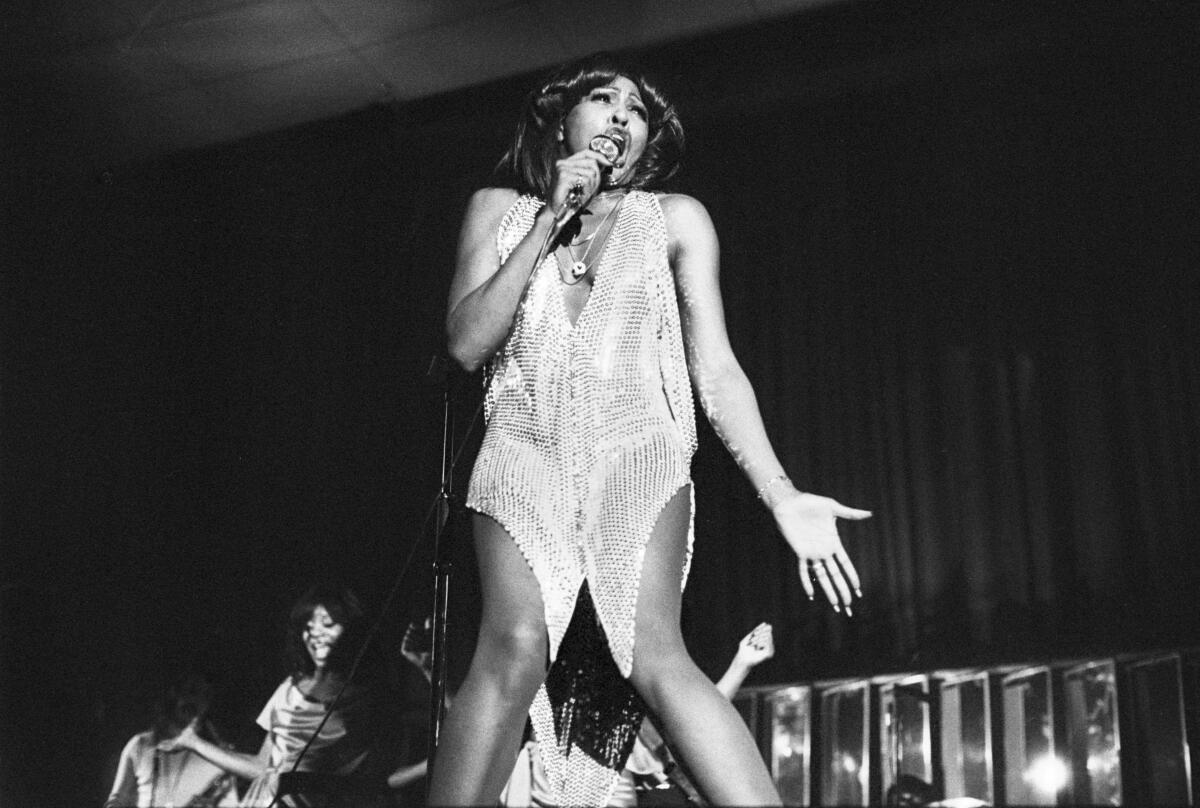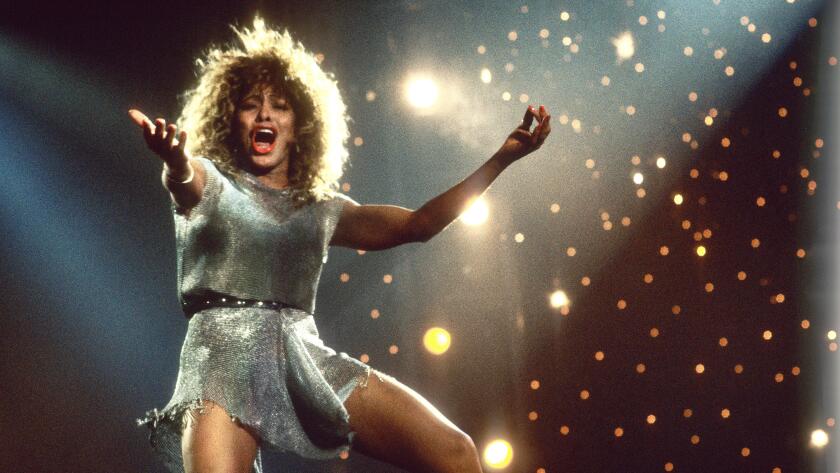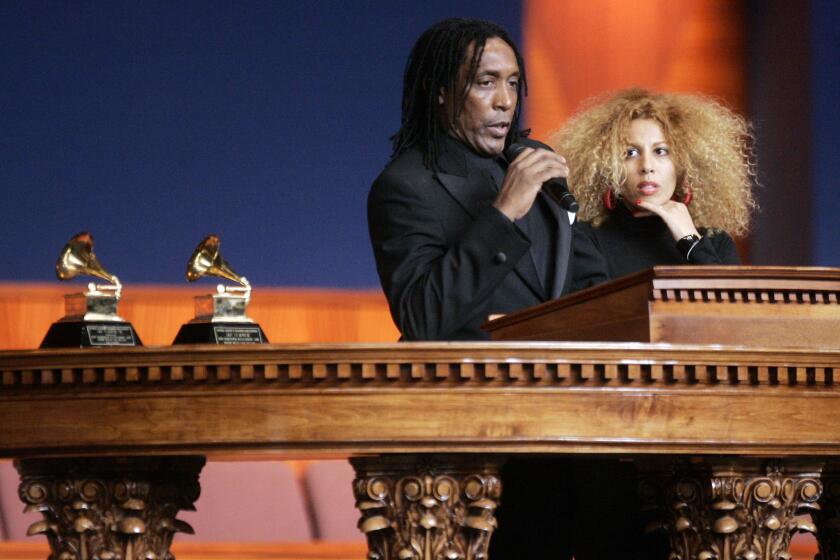Tina Turner, resilient star who sang ‘Proud Mary’ and ‘What’s Love Got to Do With It,’ dies
- Share via
Grammy-winning Tina Turner was a rock ’n’ roll original with her high-octane, powerful yet soulful voice and iconic hairstyles.
- Share via
For Oprah Winfrey, bearing witness to one of Tina Turner’s frenetic, high-octane performances was nothing short of a spiritual experience.
“Each electrifying swing of her miniskirt, every slide of her 3-inch Manolos across the stage, sends a message: I am here. I have triumphed. I will not be broken,” Winfrey said.
A powerhouse singer capable of squeezing every possible emotion out of songs such as “Proud Mary,” “River Deep, Mountain High” and “What’s Love Got to Do With It,” Turner died Wednesday at her home in Küsnacht, near Zurich.
Turner’s death was announced in a statement from her manager, Bernard Doherty, who said she died following a long illness. She was 83.
“Even after the countless awards, the 180 million album sales, the record-breaking tours, and unforgettable acting roles, Tina will be remembered most through the sheer joy of her music,” Max Lousada, chief executive of recorded music for Warner Music Group, said in a statement. “So powerful is her extraordinary, universal appeal that there is no doubt she will continue to influence generations to come. She stands as the epitome of artistic self-empowerment.”
Here are 10 of Tina Turner’s unheard treasures. The music legend died Tuesday at 83.
The Grammy-winning vocalist overcame an abusive marriage and decades of adversity before being fully embraced as a rock ’n’ roll original who exuded a raw sensuality with her commanding yet soulful voice, million-dollar legs and iconic hair.
Though she ignited her own blazing legacy in the recording studio and concert halls around the world, Turner’s personal and professional history are inextricably linked to that of her late ex-husband, Ike Turner. Her transformation into a superstar eventually eclipsed the revered and reviled Ike, who was a highly regarded talent scout, guitarist, pianist and record producer long before he discovered Tina when she was just 18.
“One evening when the drummer gave my sister the mic, I took it,” she recalled in 2005. “I could do B.B. King songs with all the emotion. Ike said, ‘Girl, I didn’t know you could sing,’ and I was so happy, because he was bigger than life. That’s when I knew I wanted to be an entertainer.”
Dave Grohl, Carole King and Tina Turner will be all be inducted into the Rock Hall for a second time.
Born Anna Mae Bullock, she changed her name to Tina at Ike’s behest and allowed him to shape her live-wire stage persona — renaming his band the Ike & Tina Turner Revue. They were married in 1962, two years after the birth of their son Ronald.
The duo rose to fame with their first single, “A Fool in Love,” which reached No. 2 on the R&B charts in 1960. They scored numerous hits in the years to follow, including “Poor Fool,” “It’s Gonna Work Out Fine,” “Proud Mary,” “I Want to Take You Higher,” “Nutbush City Limits” and “River Deep, Mountain High.”
Tina Turner’s dynamic stage presence became as memorable as the duo’s records and took the act far beyond the R&B scene in 1969 when they opened for the Rolling Stones on the rock band’s North American tour, with her often singing duets with Mick Jagger.
When the couple’s tumultuous relationship came to an end — Turner said she walked out on Ike in the 1970s following a vicious limo dispute in Dallas and years of domestic abuse allegations — she launched her solo career but hung onto her husband’s name.
She filed for divorce in 1974 and their marriage officially ended four years later. Ike Turner died in 2007 from a cocaine overdose at 76, but their fractured history continued to make headlines even after his death.
Though brimming with confidence, Turner adopted the vulnerable persona of a survivor as she poured her struggles and hardships into her music. Her performances were often so energetic that the media referred to her as “TNTina.”
Now that Broadway is agog over “Tommy,” why not “Tina”?
Her career stalled in the aftermath of her divorce, but she mounted a stunning comeback in 1984 with the album “Private Dancer,” which sold more than 10 million copies and scored four Grammy Awards.
Two years later, she released “Break Every Rule” and published her bestselling memoir, “I, Tina,” which detailed the years of violence she said she endured with Ike. Their stormy relationship drew attention again in 1993 when her memoir was adapted for the screen in the film “What’s Love Got to Do With It?” The biopic starred Angela Bassett and Laurence Fishburne, both of whom earned Oscar nominations for their portrayals of the volatile duo. A jukebox musical about Turner’s life premiered in London’s West End in 2018, then moved to Broadway, and the singer was featured in the stirring 2021 documentary “Tina.”
“How do we say farewell to a woman who owned her pain and trauma and used it as a means to help change the world?” Bassett said in a statement to The Times.
“Through her courage in telling her story, her commitment to stay the course in her life, no matter the sacrifice, and her determination to carve out a space in rock and roll for herself and for others who look like her, Tina Turner showed others who lived in fear what a beautiful future filled with love, compassion, and freedom should look like.”
When asked if she was surprised by the peaks and valleys of her life, Turner said no: “I’m not surprised, because I’ve always wanted this. And I won’t stop until I get that respect,” she told Rolling Stone in 1986. “I may not ever get it completely, because my life has been too hard so far. But I’ve gotten a taste of what that respect is probably like, and I like it.”
Turner was born in Nutbush, Tenn., in 1939, and her father led a crew of sharecroppers and was a deacon at the church the family attended. She recalled that, though her parents had little formal education, they seemed filled with common sense. Her parents also fought frequently. Her mother left the family when Turner was 10, as did her father three years later.
“I’m a strong person, because I had dealt with problems when my mother and father separated and I went from relative to relative and had problems in school,” she told The Times in 1998. “It was tough all the way, so my skin was already toughened to the life and striving to get through. I didn’t dwell on it, I just kept going.”
Turner said she was stung by the racism she encountered as a youth and later as a performer.
“I am looked down upon because I’m Black,” she told The Times. “It’s forever. It’s like a curse on you.”
“Tina: The Tina Turner Musical” seems like a no-brainer, but the singer wasn’t always keen on the idea. And the transfer from London required tweaks.
Turner often lived with her paternal grandmother and worked as a babysitter for a white family whom she would later credit for pushing her to get a good education. She moved to St. Louis when she was 16 to be with her mother and began singing in talent shows. It was at one of the shows that she came across Ike Turner’s R&B band, Kings of Rhythm. She started dating saxophonist Raymond Hill and the two had a child, Craig, when she was 18.
She had planned to go to nursing school, but when the Kings of Rhythm lost their lead singer, Ike asked her to join the band, renaming it the Ike & Tina Turner Revue.
Ike’s reinvention of her image made her a sex symbol, catalyzed by one particular song: her smoky cover of Otis Redding and Jerry Butler’s “I’ve Been Loving You Too Long.”
With the help of producer Phil Spector, the band crossed over to pop in 1966 with the landmark record “River Deep, Mountain High,” built around her soaring vocals and Spector’s symphonic “wall of sound.” Though it only reached No. 88 on the Billboard charts, it came to be regarded as one of the defining singles of the 1960s and was inducted into both the Grammy Hall of Fame and the Rock & Roll Hall of Fame. Tina and Ike Turner were inducted into the Rock & Roll Hall of Fame in 1991.

Tina Turner was inducted as a solo artist in 2021, making her one of only three women in the institution’s history to be inducted twice. (Fleetwood Mac’s Stevie Nicks and singer-songwriter Carole King are the others.)
In the late 1960s the Rolling Stones invited Ike and Tina Turner to join their U.K. tour and added them to the American leg of their world tour in 1969, their performances captured in the 1970 film “Gimme Shelter.” That unexpected success and the sheer size of the crowds prompted Ike to have Tina record covers of rock songs, including the Beatles’ “Come Together” and Creedence Clearwater Revival’s “Proud Mary,” which became their first U.S. top 10 hit and their first million-selling single. It also earned Turner the first of her eight Grammy awards.
“She’s one of the first women performers I worked with who has the same aggressive thing that I’ve got,” Jagger told Rolling Stone in 1995. “A lot of women performers are quite static — or certainly were in the ’60s. They did their best, but they weren’t like Tina. She was like a female version of Little Richard and would respond to the audience — really go out and grab them.”
Paying tribute to Turner, Jagger tweeted that she was “inspiring, warm, funny and generous. She helped me so much when I was young and I will never forget her.”
Turner said Ike was more like a sibling at first, fun-loving and carefree. But the longer they lived together, she said, the more abusive he became, hitting her and forcing her to have sex with him. He “acted as if that was a normal part of the relationship,” she said.
“It was a thoroughly unhappy situation I was in, but I was too far gone,” she told Rolling Stone. “It’s hard to explain. This man was beating me — I always had a black eye or something, and he had women all over the place, and he wouldn’t give me any money — and yet, I didn’t leave. I felt sorry for him.”
She said she attempted suicide by overdosing on Valium, unsure how else to escape the relationship.
Tina Turner’s son Ronnie Turner died outside his home last week at 62. An autopsy shows he died of complications related to metastatic colon cancer.
In July 1974, Ike started a fight by slapping the back of her head, according to Turner’s memoir. When the two emerged from the limousine, they both were bloodied and bruised. She said it was the first time she fought back.
“I took everything God gave me for granted: Tina, my family, my career,” Ike Turner told The Times years later when he was released after 18 months in prison for probation and drug-related violations.
After the limo altercation, while Ike was sleeping, Turner walked out with just 36 cents in her pocket. With the help of friends, she moved to Los Angeles and began life anew, though she struggled to regain momentum, often working in Las Vegas showrooms and appearing on game shows such as “Hollywood Squares.”
What would become a remarkable second act began in 1984 with her solo album “Private Dancer,” which spawned the hits “What’s Love Got to Do With It” and “Better Be Good to Me.” She continued to perform and record until 1999, when she released “Twenty Four Seven,” her 10th and final solo album.
She had several prominent roles in films, notably as the Acid Queen in the film version of the Who’s rock opera “Tommy” and appearing alongside Mel Gibson in “Mad Max Beyond Thunderdome.” She turned down Steven Spielberg’s offer to cast her in “The Color Purple,” saying the storyline was “too close to what I just stepped out of,” the Guardian reported.
When her 1986 autobiography, “I, Tina,” became a national bestseller and the subsequent film “What’s Love Got to Do With It?” a hit, Turner said she was startled that her story of survival was inspiring to so many.

“I had no idea that it would do what it did in terms of inspiring a lot of women — and actually what it did to a lot of men,” she said. “It had an impact on a lot of people, and I’m happy about that, because it’s almost like poison turned to medicine in some kind of way.”
After more than four decades of steady touring, Turner announced her retirement in 2000 but was back on the road before long. She retired for good in 2009. She received a Kennedy Center Honor in 2005 and a Grammy Lifetime Achievement Award in 2018.
“As long as you’re healthy and you’re in good shape, people will always come to see you as long as you have something to offer in terms of talent,” she said of performing in her later years. “I hope I’m not stomping around on the stage at 80. But if I am and it gives great support to women to say they can still do it, then why not?”
In 2013, she relinquished her U.S. passport and became a Swiss citizen, citing an ancestral connection to the country. She married her longtime music manager Erwin Bach in a civil ceremony in Zurich. The couple had lived in a waterfront estate in Zurich since 1995. Turner sold her music catalog to the German music corporation BMG for a reported $50 million in 2021.
“With her music and her boundless passion for life, she enchanted millions of fans around the world and inspired the stars of tomorrow,” a post on her official Instagram account said Wednesday. “Today we say goodbye to a dear friend who leaves us all her greatest work: her music. All our heartfelt compassion goes out to her family. Tina, we will miss you dearly.”
Turner is survived by Bach. Her son Ronnie Turner died of complications related to late-stage cancer and cardiovascular disease, in 2022. Her son Craig Turner died by suicide in 2018.
More to Read
The biggest entertainment stories
Get our big stories about Hollywood, film, television, music, arts, culture and more right in your inbox as soon as they publish.
You may occasionally receive promotional content from the Los Angeles Times.














